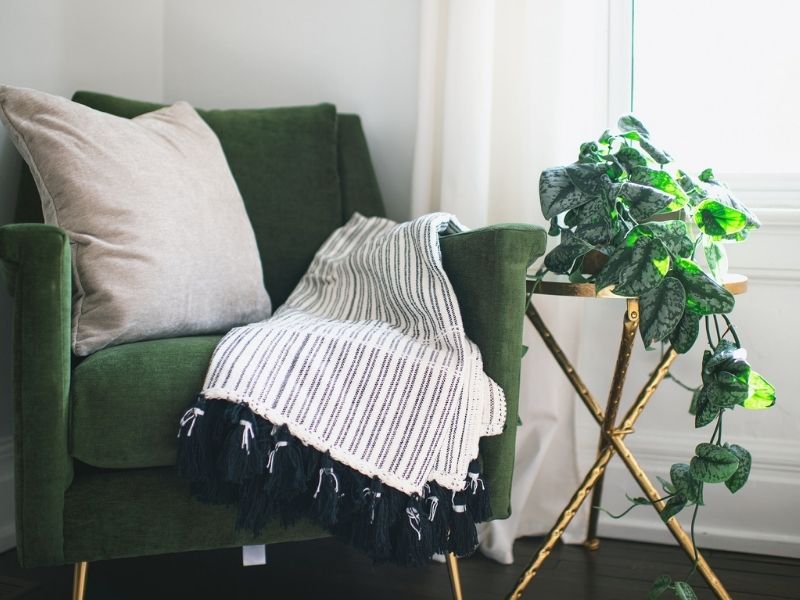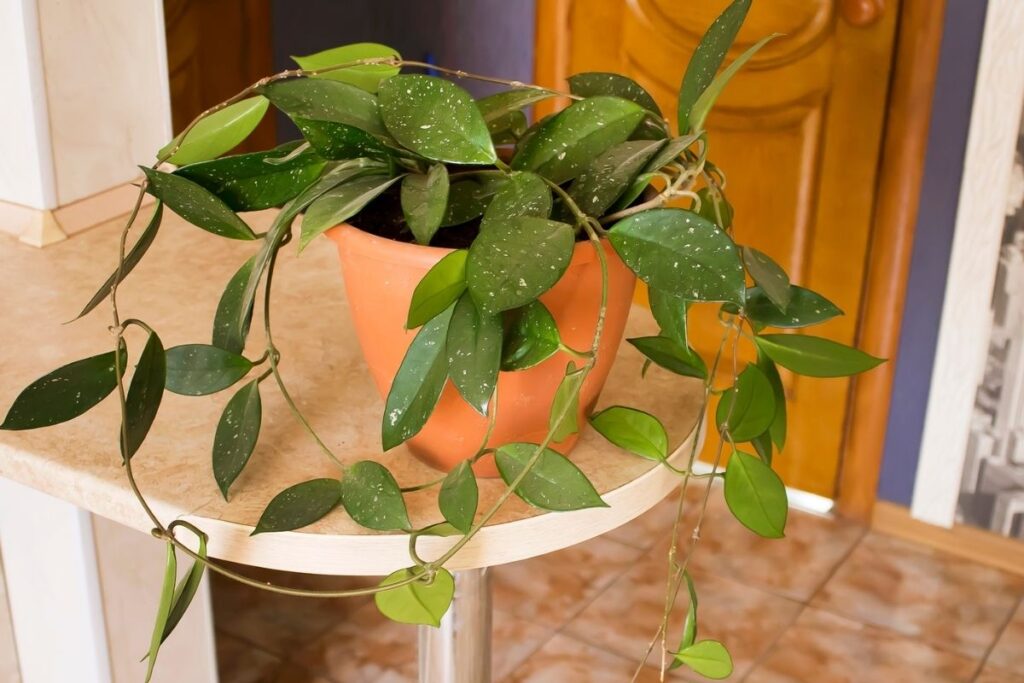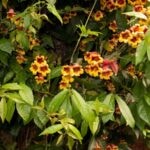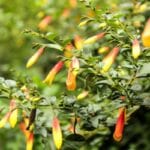Vining and climbing plants can add a much-needed outdoor aspect to your indoor space. Indoor plants are kept anywhere from the kitchen to your office space, and are popular year round for that much-needed mood boost in the middle of your workday.
Vining and climbing plants are an especially fun variety to grow indoors because of their sprawling qualities. They add a jungle-type feel to any room, and are great for home design. Some of these plants are better than others when it comes to indoor use; let’s explore some of the best.
Indoor vine plants can bring much-needed light to an indoor space, even in the wintertime. Vining and climbing plants can be especially lightening.
Ivy

Arguably one of the most popular choices for indoor vining plants and one of the fast growing indoor vines, ivy comes in all different varieties. Ivies are a great choice for an evergreen plant that does exceptionally well in indoor spaces because of its adaptability to low sunlight. Ivy actually does best in indirect sunlight, but should still be in a location that receives indirect sun for a majority of the day.
Ivy can be trained to grow up a small trellis or string and is easily manipulated into different shapes and designs. A popular choice for growing indoor ivy is to hang the planter from the ceiling and let the ivy drape down from the planter.
Heartleaf Philodendron
The heartleaf philodendron is a great indoor plant for beginners, as it is relatively simple to take care of. This is an evergreen plant that can thrive in an indoor planter for a few years with very little attention. Lightly misting the leaves is the best way to keep the plant watered, but it does not require much water to survive.
The most important care tip for the heartleaf philodendron is to keep it from sprawling out too much. Simply pinching off extra growth will keep this plant in a healthy state of growth without becoming overgrown.
Jasmine Vine
There are some varieties of vining jasmine that grow well indoors. Jasmine vines do best in direct sunlight, so a south-facing window sill may be the best location to keep this vigorous vining plant. The jasmine vine prefers cooler temperatures between 60-75 degrees Fahrenheit, making an indoor setting ideal.
A small trellis or wire stand is ideal for the jasmine vine as it likes to grow upwards. Additionally, hanging baskets can also be a great choice for cultivating jasmine indoors. The jasmine vine is a fragrant plant that produces small blooming flowers in the spring.
If you are looking for some indoor flowering vines that smell good, the jasmine plant is for you.
Pothos

If you have a low-light area of your house that you’d like to spruce up with a houseplant, the pothos plant may be a good choice. Pothos need very little sunlight to survive, and do well with indirect lighting.
The pothos plant also does well in dry soil, meaning that it will live through a vacation or a forgetful owner. When it comes to soil, pothos is very adaptable. Although they appreciate nutrient-rich soil, they do just fine in soil with little nutrients.
Pothos will also grow in a vase of just water, no soil required. Many will start their plants this way before transferring them to a pot with soil.
Inch Plant
The inch plant is another highly versatile plant that will grow well in either direct or indirect sunlight, and can tolerate low-light environments if needed. Both a corner of a small room with a single window and a window sill are appropriate places to keep your inch plant.
The inch plant is fairly hands-off, and only needs to be kept moist, meaning that you won’t have to water every day. As long as the soil is not too dry and not saturated, your inch plant will do just fine.
Creeping Fig
The creeping fig is a vining plant that does well inside. It requires bright (but indirect) sunlight to thrive, and the soil should be kept moist not too dry but not saturated either.
The creeping fig will sprawl if you let it, but can also be trained to climb a trellis, moss pole, or even a wall with proper care. There are some neat design tricks that can be done with the creeping fig due to its versatile growing nature. Some keep them sprawling on a tabletop, while others let them climb up their walls.
Wax Plant
The Wax Plant, or Hoya carnosa, is a famous indoor plant loved for its pretty leaves and fragrant flowers.
Native to Eastern Asia and Australia, this resilient vine features thick, waxy leaves that are typically green or variegated. Hoya carnosa produces clusters of star-shaped flowers with a sweet, honey-like scent, making it a favorite among plant enthusiasts. Ideal for hanging baskets or trellises, this low-maintenance vine thrives in bright light and well-draining soil.
With the right care, like giving it a little water here and there and regularly cutting back, Hoya carnosa can grow well indoors. Its lovely blooms and vining growth habit will add beauty and charm to any living area.
Arrowhead Plant
Syngonium podophyllum, commonly known as Arrowhead Vine, is a delightful houseplant cherished for its arrow-shaped leaves and a variety of captivating colors.
This trailing or climbing vine is an ideal choice for indoor cultivation due to its low-light tolerance and ease of propagation. The leaves transition from dark green and white to lime green and bright pink as they mature.
Monstera
Nicknamed the “Swiss Cheese Plant” for its split leaves, it adds a touch of the tropics to your home. Monstera, belonging to the Monstera genus, is a popular indoor vine renowned for its large, glossy leaves.
Originating from tropical regions of Central and South America, Monstera plants are treasured for their lush foliage and easy-care nature. Their iconic fenestrated leaves develop as the plant matures, adding to its exotic allure.
How to Care for Indoor Vines
As with any plants, watering is of crucial importance, although many houseplants won’t require constant watering. Most indoor vines need to be kept moist, but not overwatered, making them a good addition for the forgetful types. To keep your plants from becoming overwatered, drainage holes in the planters will provide a source for excess water to escape.
Knowing the sunlight requirements of your plants is another important aspect to consider when caring for your plants. A majority of houseplants do not require direct sunlight, and will do just fine with indirect light throughout the day. For plants that do need more access to the sun, placing them in a south-facing window sill is ideal for maximum sun exposure.
Some indoor plants particularly vining and climbing plants will need to be trimmed back in order to keep them from becoming overgrown. If routinely checked, simply pinching off excess growth is the easiest way to keep them trimmed. If growth starts to get out of hand, you may need to dig out some trimming scissors to tame those wild branches.
Why Grow Indoor Plants?
There are several reasons to grow plants indoors, including some health benefits. For many, keeping vine house plants is a mood enhancer. Having a piece of the outside world with you as you work or take care of your indoor chores can help relieve stress for some. As it turns out, there may actually be some health benefits to keeping indoor plants as well.
As we know, plants absorb the carbon dioxide that we release when we breathe or talk, and in turn, release oxygen. Keeping indoor climbing plants can help to improve the quality of your air by circulating in fresh oxygen and taking out some of the carbon dioxide.
There are also claims that indoor plants are effective in removing harmful toxins out of the air. So your indoor vine plant may be making you feel better on a physical level more than just an emotional level!
FAQs
What is the fastest growing vining houseplant?
The fastest-growing vining houseplant varies depending on growing conditions, but some fast-growing options include pothos (Epipremnum aureum), heartleaf philodendron (Philodendron scandens), or devil’s ivy (Scindapsus pictus).
What is the best indoor vine for low light?
The best indoor vine for low light conditions is typically pothos (Epipremnum aureum) or heartleaf philodendron (Philodendron scandens). These plants can tolerate low light and are known for their ability to thrive in various indoor environments.
Why is my indoor vine plant dying?
Several factors could cause an indoor vine plant to decline or die, including overwatering, underwatering, inadequate light, pests, diseases, or environmental stressors. Assess the plant’s growing conditions and adjust watering, light exposure, and care accordingly to revive it.
What is the easiest climbing vine to grow?
The easiest climbing vine to grow indoors is often considered pothos (Epipremnum aureum) or heartleaf philodendron (Philodendron scandens). These plants are resilient, adaptable, and forgiving of occasional neglect. They can tolerate a wide range of growing conditions, including low light, and are relatively pest-resistant.
Up next: Best Air Purifying Plants
*image by Svetlana8Art/depositphotos







